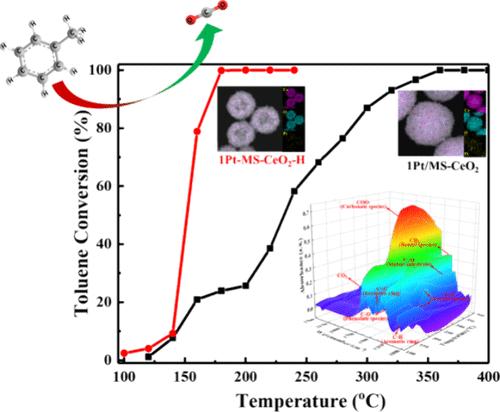具有先进催化性能的铂包介孔 CeO2 中空纳米球氧化甲苯
IF 4.7
2区 化学
Q1 CHEMISTRY, INORGANIC & NUCLEAR
引用次数: 0
摘要
本研究轻松制备了铂含量(0.5-3.0 wt %)不同的新型铂嵌入介孔 CeO2 中空纳米球(Pt-MS-CeO2-H)。铂纳米颗粒被一次性嵌入到 Pt-MS-CeO2-H 的介孔外壳中,并有助于还原奥斯特瓦尔德熟化过程。传统的制备方法往往面临纳米粒子分布不均或聚集等难题,而且难以在低铂含量下保持高催化活性。与传统的支撑型 Pt/MS-CeO2 催化剂相比,包埋策略有助于精确控制铂纳米粒子在 CeO2 介孔壳内的位置、分布和均匀性。此外,铂纳米颗粒的包埋过程在产生氧空位和激活氧的表面化学吸附方面发挥了关键作用。因此,1Pt-MS-CeO2-H 催化剂的甲苯氧化性能 T90(171 °C)远低于 1Pt/MS-CeO2(311 °C)。为了阐明其根本原因,我们采用了甲苯氧化的原位漫反射红外傅立叶变换光谱来确定这些催化剂的反应中间体和途径。总之,铂嵌入介孔 CeO2 中空纳米球催化剂被认为是设计高性能甲苯催化氧化催化剂的潜在候选材料。本文章由计算机程序翻译,如有差异,请以英文原文为准。

Oxidation of Toluene over the Pt-Embedded Mesoporous CeO2 Hollow Nanospheres with Advanced Catalytic Performances
In this study, the novel Pt-embedded mesoporous CeO2 hollow nanospheres (Pt-MS-CeO2-H) with varying Pt contents (0.5–3.0 wt %) were facilely prepared. The Pt nanoparticles were one-pot embedded within the mesoporous shell of Pt-MS-CeO2-H and assisted with the reduction Ostwald ripening process. The traditional preparation methods often face challenges, such as the uneven distribution or aggregation of nanoparticles, as well as difficulty in maintaining high catalytic activity at low Pt content. Compared with the traditional supported Pt/MS-CeO2 catalyst, the embedding strategy facilitated precise control over the position, distribution, and uniformity of Pt nanoparticles within the CeO2 mesoporous shell. Additionally, the encapsulation process of Pt nanoparticles played a pivotal role in generating oxygen vacancies and activating surface chemical adsorption of oxygen. Resultantly, the toluene oxidation performances of 1Pt-MS-CeO2-H catalyst showed much lower T90 (171 °C) than 1Pt/MS-CeO2 (311 °C). To elucidate the underlying reasons, in situ diffuse reflectance infrared Fourier transform spectroscopy of toluene oxidation was employed to identify the reaction intermediates and pathways over these catalysts. In summary, the Pt-embedded mesoporous CeO2 hollow nanosphere catalysts were considered as potential candidates when designing high-performance toluene catalytic oxidation catalysts.
求助全文
通过发布文献求助,成功后即可免费获取论文全文。
去求助
来源期刊

Inorganic Chemistry
化学-无机化学与核化学
CiteScore
7.60
自引率
13.00%
发文量
1960
审稿时长
1.9 months
期刊介绍:
Inorganic Chemistry publishes fundamental studies in all phases of inorganic chemistry. Coverage includes experimental and theoretical reports on quantitative studies of structure and thermodynamics, kinetics, mechanisms of inorganic reactions, bioinorganic chemistry, and relevant aspects of organometallic chemistry, solid-state phenomena, and chemical bonding theory. Emphasis is placed on the synthesis, structure, thermodynamics, reactivity, spectroscopy, and bonding properties of significant new and known compounds.
 求助内容:
求助内容: 应助结果提醒方式:
应助结果提醒方式:


